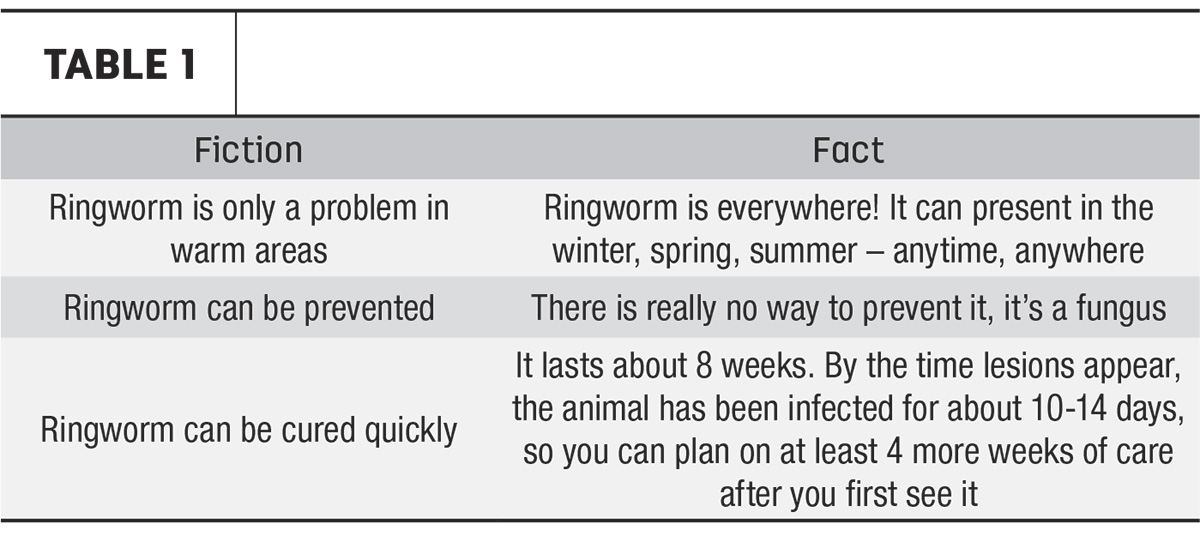To read this article in French, click here.
Several years ago, a young person wrote a letter to a government official asking him to change the rules so that cattle with ringworm could be exhibited at county fairs. Even at the age of 10, she’d had enough experience with the fungus to know that while it is unsightly, it really isn’t that harmful to cattle. Each year we hear from people asking about ringworm and how to get rid of it so that they can go to the show. Let’s compare facts and fiction.
Ringworm is a fungus that is highly contagious and can be passed from cattle to humans. It presents as a skin lesion that is round and itchy. The fungus lives in dark, damp places – it can live in the wood of a barn for years. It can be transmitted from halters, clipper blades, brushes and other show equipment or by skin-to-skin contact.
Vaccines are available to treat cattle for ringworm, but they need to be administered in a timely manner before a breakout or right after. Many times, the disease goes unseen until an animal is clipped off or shows the lesions, making the vaccine ineffective. Some animals have immunity to it and don’t break out with round lesions but can still be a carrier. Most of the time, once an animal has ringworm, they won’t get it again. On a rare occasion, they may pick up a different strain and show signs of it. Humans aren’t immune and can get it more than once.

What can you do about it? Here are some tips to battle ringworm:
- Have a good deworming program and be consistent with it.
- Keep your show animals clipped off so you can carefully monitor skin conditions.
- Let animals out in the sunshine – vitamin D is always good, and the sunshine will help dry lesions out.
- Do not scrap lesions off – this just causes more pain and it will take everything longer to heal.
- Use a skin conditioner. There are many livestock products available that will help heal and promote hair growth on the lesion – a sign that the fungus is dead. Keeping lesions soft will promote healing and hair regeneration.
- Old remedies such as iodine, motor oil and bleach have been replaced with medicated and healing conditioners formulated to use on livestock. There is no evidence that these abrasive products ever worked on ringworm, and they aren’t designed for use on livestock.
- Cut down on your daily rinsing. Let the lesions heal for a few days in between rinses.
- Daily brushing with a soft brush will help promote natural oils and healing. That brush should then be marked for ringworm animals only as the ringworm fungus could live there permanently.
- Clip ringworm-infested animals last and then thoroughly clean the blades by removing them from the clippers and placing them in a cup of clipper oil for 24 hours. Blades can’t hold the fungus in them because they are not porous. But if you clip an infected animal and go right to the next, there is a good chance of spreading the fungus.
- Keep stress to a minimum. Feed changes, environmental moves and other factors that cause stress can lead to more severe cases. A daily routine helps minimize stress and minimize the fungus.
The hardest part about the ringworm fungus is that it will very often present itself shortly before a show that you’ve worked all year for. Unfortunately, with the health requirements for exhibiting cattle, if the lesion has no hair growth, you will probably not be able to keep it at a show. I would encourage you to have your veterinarian look at the lesions a few days before you leave for the show to give you a professional opinion on whether to take the heifer. A health paper with a good-to-go signature is worth a lot at a show's health check-in.
Ringworm is contagious and can be picked up almost anywhere, but it is rarely a problem beyond the unsightly lesions. Eliminating infected cattle from an exhibition won’t contain the problem, it just causes stress and disappointment for young exhibitors. Perhaps the simplest solution is to work to get the rule changed. Consider writing a letter to your agriculture government official telling them what you know about ringworm. Just maybe your letter will be the one to make a difference.







